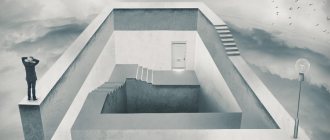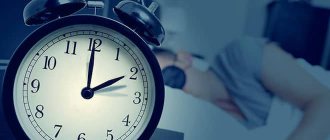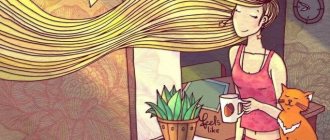The theory of Owls and Larks is less than 50 years old. Until the 70s of the last century, anyone who could not wake up at seven in the morning was simply called lazy.
The good news is that belonging to an Owl or a Lark is still determined genetically. In science, this is called a chronotype, that is, a certain type of daily activity. So, there is a certain combination of genes characteristic of different chronotypes.
Somnologist Mikhail Poluektov, Candidate of Medical Sciences, Associate Professor of the First Moscow State Medical University named after. I.M. Sechenova, I am sure that genetics determines our belonging to Owls or Larks by 54%. 3% is the age factor. But the remaining 43% comes from social factors.
What chronotype are you?
Owl. You wake up only at 9 am, but a comfortable awakening is around noon. Amazing ideas come to you in the evening or at night. You kick yourself to bed long after midnight.
Lark. You don't need an alarm clock, you consistently wake up at six or even five o'clock in the morning. It is best to work before noon; after lunch it is more difficult to concentrate. In the evening you can hardly catch up on your favorite series, and then you fall asleep halfway through the episode. 22:00 – the body calls it quits.
Pigeon. You wake up cheerfully to the alarm clock at 7 am. You feel great all day, you can easily cope with complex tasks both in the morning and in the evening. You go to bed at 22-23 o'clock, before this time you are quite capable of working a little more.
Dove's daily routine
The conducted studies indicate that the most balanced and most adapted to the modern rhythm of life and working conditions is the “pigeon” human chronotype. Since the generally accepted mode of activity, the rest schedule is most consistent with pigeon biorhythms. In addition, “pigeon” people can easily and without harm to their own physiological state adapt to almost any schedule. For example, “larks” are characterized by excellent health indicators and poor plasticity of biorhythmic processes; any change in the usual routine has a negative impact on their well-being.
Judging superficially, it may seem that the least fortunate are “night owls”, because their performance is activated when all colleagues leave the workplace and health indicators are significantly inferior to those of “early people”. However, by the age of fifty, it becomes obvious that night owls are still healthier than their “feathered antipodes.” This is explained by the high level of adaptation potential. In addition, people who live at night are less prone to stress.
Sociologists say that people who are “larks” are more predisposed to diseases of the myocardium, “pigeons” – of the nervous system, and “owls” – of bones and joints.
“Larks” are successful in activities that require accuracy, diligence and scrupulousness, “owls” are most suitable for creative professions, and “doves” are most suitable for leadership positions.
The “pigeons” have a comfortable time of awakening somewhat later than their “brothers.” The period of maximum physical vivacity and mental activity falls in the period from 10 to 18 hours. The described category of people usually leaves for the Morphean kingdom at approximately 11 p.m.
The “pigeon” chronotype is better adapted than others to the alternation of light and darkness. A shift in his personal biological clock occurs only when traveling over long distances, due to a change in time zones. For example, he may experience insomnia at night due to a 3-hour time difference and drowsiness and lethargy during the day. Such moments lead to a general decrease in performance. It is worth emphasizing that when moving in a western direction, “pigeons” experience a lengthening of biological rhythms, and traveling to eastern countries causes them to shorten. The “pigeon” chronotype of people prefers food that is balanced, unsaturated with fats and harmful ingredients.
Biologists claim that the biorhythmic processes of the “pigeon” make it possible to display the same activity both in the morning and in the evening. For them, gymnastic exercises will be equally useful both in the light of the rising sun and in the shining of the moon. An important condition for the excellent well-being of the “pigeon” chronotype is afternoon relaxation.
In addition, the described chronotype has one significant feature - their internal clock “mechanism” is easily disrupted. In order to always exist in an adequate rhythm, it is necessary to help the body with endorphins, which are produced when a person does something pleasant for himself.
Which chronotype is easier to live with?
Scientists have not yet been able to divide the Earth's population by chronotype in percentage terms. According to some data, in developed countries, 40-45% of city residents are Owls, 25% are Larks, 30-35% are Pigeons.
Others say that the absolute majority of people by chronotype belong to Larks and Pigeons, and there are only two or three “pure” Owls per thousand.
Why then does everyone insist that they are Owls and demand that this be taken into account?
Perhaps the reason is in common stereotypes - we have sorted out the 7 most inveterate ones.
What kind of psychotypes are these?
All types have special characteristics. Early birds have been considered attentive and special since ancient times. They are distinguished by their ability to see what others cannot see.
Night birds do not boast of having such abilities. They prefer to go to bed early and wake up with the sunrise. The ability to see subtle nuances is a talent. They become professional photographers, artists, poets. Able to realize themselves in art and creativity.
It is a mistake to divide people into two types. Besides them, there is a third one - pigeons. Given the circumstances, they may go to bed late and wake up early, or vice versa. They easily change their routine without harming their own psyche. For other psychotypes this is difficult to do.
The owl man prefers to stay awake at night. They are distinguished by a deep psyche. Sensitive sleep. Even a small rustle can cause you to wake up. He loves to philosophize and dream. Poets and writers are often found among these.
Larks have better health
Most scientists agree with this point of view. In the course of evolution, humans have adapted to a daily lifestyle. In addition, only in a dream, and even in complete darkness, a person produces the hormone melatonin.
Lack of melatonin leads to breast and prostate cancer. Data obtained from a study in Iceland. For seven years, scientists observed patients with sleep disorders, the result was disappointing - out of 1000 people, 111 had prostate cancer, and in women there were numerous cases of breast cancer.
However, there are other results. Tatyana Grechenko, Doctor of Psychology, leading researcher at the Institute of Psychology of the Russian Academy of Sciences, cites research data from Japanese doctors.
It turned out that among the Larks there are more people with excess weight, hypertension and heart disease. And Owls are more resistant to stress.
Who is right?
However, the truth is that scientists’ attempts to “reshape” the biorhythms of living beings failed - it turned out that it was impossible to do this without harm to health. According to somnologists, it is possible to optimize the work process only taking into account the individual characteristics of employees, but a forced transition to a “lark” will bring nothing but harm.
“Once I had to disrupt my entire life schedule (and I’m a typical “biological night owl”) in order to perform some early official functions,” says Anna from Moscow
. “I started to feel depressed and my performance decreased. This lasted for several months. Moreover, I didn’t solve any serious problems in the morning mode, I just sat through the allotted hours in a half-dead state, but this killed my entire schedule and paralyzed the solution of serious problems. Then, during the New Year holidays, I returned to night mode, and everything stabilized. But after the end of the holidays I was again forced to adapt to the early schedule, and complete “trash” began. In the very first weeks of such a life, in addition to a critical loss of working capacity, general weakness and depression, I developed psychosomatics and my immunity dropped. Despite the fact that in peacetime - neither in summer nor in winter - I practically do not get sick, I was immediately blown away on the street, some other problems began, everything came out that had never happened. As a result, I spent almost a month on antibiotics. Now the schedule has returned to the nightly norm, and (knock on wood) I have no complaints about my well-being and performance.”
Russian researchers of the problem, for their part, note: from early childhood, people are terrorized by early rises and initiation into adult life with “cold and darkness”, so that the morning is associated exclusively with violence against oneself and the need to drag oneself to hard labor, but there is no particular need for this. The labor productivity of owls is higher, and they “screw up” only if they are forcibly transferred to the morning mode.
Owls are smarter, but lazier than Larks
And this is mostly true.
Psychologists Richard Roberts and Patrick Kyllonen studied 420 volunteers and found that Owls performed better than Larks on many measures of intelligence, with greater working memory capacity and faster processing speed. And even in the morning hours that are unfavorable for them.
In 1997, Joseph Ferrari, based on a study of students and people over 50 years old, proved that Owls are more prone to procrastination. Larks are more disciplined and responsible.
According to other studies, Owls are resourceful and creative, with many extroverts among them. But Larks are conscientious, usually in good standing with their superiors, and prone to analytical work.
What's special
All people, regardless of their character, are special and individual. An owl or a lark have certain differences that make it possible to divide personalities into psychotypes.
Traits and character traits help determine the level of performance and endurance. Many employers take this information into account during interviews.
"Zhavoronkov"
This type belongs to creative, positive, joyful personalities. Everyone knows that they prefer to go to bed early and wake up with the sunrise. This is how they get energy for the whole day.
If they sleep late, they will feel uncomfortable all day long. This is due to a violation of their usual routine.
You can rarely find them irritable and angry. They generally look at any situation positively.
"Owls"
The owl and the lark are complete opposites in character. They fall asleep very late and sleep for a long time. If they wake up early, they will be sleepy and lethargic all day.
A tired night owl is unable to concentrate. Naturally, she has no work activity. Therefore, they usually engage in creativity, art and love to study philosophy and psychology.
"Doves"
The “pigeons” type is universal. Sleep patterns do not affect their psycho-emotional state. Therefore, it is easy for them to adapt to the right environment.
They can work in any field without discomfort. In life, successful, focused, purposeful.
They achieve their goals. Rarely succumb to depression and stress.
If you are not an Owl or a Lark, then who else?
If you feel that you don’t fit into the traditional classification of chronotypes, Dr. Michael Breus has developed an alternative one.
According to Breus, people are divided into 4 types: Lions, Wolves, Dolphins and Bears.
Leos are optimists and are most productive in the morning. Wolves , on the contrary, prefer to work at night; they are creative extroverts. Dolphins often suffer from insomnia, are emotional and are easily upset.
Most of the bears These are people who find it difficult to get up in the morning because there are too many temptations in the evening.
How to improve your life based on your chronotype
You need to take into account the basic biorhythms and try to structure your day in accordance with them.
Remember:
- Medical procedures are easier to endure in the morning. Therefore, plan your trip to the doctor for the first half of the day.
- The body recovers faster at night, so try to sleep at night. The best sleep is before midnight
- An hour before bedtime, give up your smartphone, computer and TV. The glow of the screen does not allow the brain to fully relax
- A warm bath relaxes and puts you to sleep, a cool shower helps you wake up.
- You need to sleep 7-9 hours a day. More or less is harmful to health
- The last meal is 2 hours before bedtime. Otherwise, a full stomach will not let you sleep
Scientists have also discovered how the human internal biological clock works:
- 10 a.m. is the peak of attention. At this time, analytical work is going well, the ability to concentrate is maximum
- 14.30 – the best coordination of movements. If the job requires precision, schedule it during this time
- 15.30 – the fastest reaction. Brainstorms are best held from 14.30 to 16.00 - this is the time when there are the most ideas
- 17.00 – physical fitness at its peak. Schedule a workout or physical activity during this time. Or just walk from work to home
We determine our type and adapt to the conditions of modern society
If you find it difficult to effectively use your inner strengths, reconsider your schedule. Determining your chronotype will help you maintain spiritual balance.
There are several ways to identify the nature of activity. The method of calculating the Hildebrand index is especially popular. To determine the indicator, it is enough to measure the pulse and breathing rate. It is advisable to carry out the test early in the morning, before getting out of bed.
If the ratio is above five to one, the person is considered a morning person. A ratio of less than one in three indicates that they are owls.
A borderline value indicates a blurred chronotype. A person may be a pigeon or a mixed type.
For a more accurate result, long-term testing will be required. It is advisable to conduct the assessment over several weekdays. You need to take the average value into account.
You can also determine daily activity using body temperature. It is advisable to take several measurements - immediately after waking up in bed and an hour later. All this time a person must deal with current affairs. A stable thermometer reading indicates the chronotype of a lark. An increase in temperature of up to one degree is typical for owls.
Psychological tests have also been developed. If the result indicates increased productivity and activity at midday, the study participant is considered a morning person. The owls come to life closer to six o'clock in the evening. It is easier for pigeons to do business after 15 hours.











